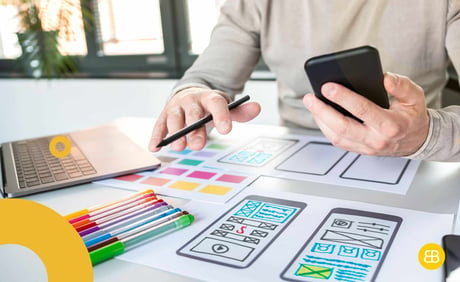Table of Contents
Do you have an amazing idea for an iPhone app? If so, you’re not alone. Lots of people come up with incredible ideas for new apps and services they would like to see on the iPhone.
You aren’t just dreaming about your unique app idea, though. You want to take action and actually bring something new and exciting to the App Store. If that sounds like you, then working with iPhone app development services is something you should consider.
Getting an app developed isn’t quite as simple as placing an order and letting a team do all the work, however. There are several things you’ll want to consider before you hire iPhone app developers. You’ll also want to have an idea of what to expect before you get started.
This article will help you get going in the right direction. Here we’ll explore the process involved in getting an app developed. We’ll also discuss the average cost to develop an iPhone app, and how you can tell if you really have a winning app idea.
Keep reading to discover everything you need to learn to get started on your own app development journey.
Is My App Idea Any Good?
Market research is one of the most important steps in any business project. Before you take your product to market you need to be reasonably confident that people will actually want it. This still applies whether it’s an iPhone app or a kitchen appliance.
Many entrepreneurs begin developing their products or businesses before gauging public demand for their idea. While there’s nothing wrong with building something just for fun, you would probably like people to download and use your app. How can you validate your idea before spending the time and money required to develop it?
The first step is to ask yourself honestly what problem your app will solve. If your idea is worth pursuing at all, you should have a very clear idea of who the app is for and what it will do.
Next, find out what other apps or services already meet this need or solve this problem. If the problem your app hopes to solve is real, there will most likely already be an existing option on the market. It’s usually a bad idea to create something that’s never been done before because that makes it harder to find people looking for a solution like yours.
Once you’ve identified other apps or products that already solve the problem, ask yourself how your app idea is different and better. Does it solve the problem faster? Does it meet the need with less cost or hassle than competing services?
If you can confidently say that your app will meet a definite need for a substantial group of people and that it will do so better than anything else on the market, then you probably have a great app idea.
How Much Will it Cost to Develop an iPhone App?
Before you can confidently launch a project for a new app, you’ll want to know how much it could cost. But as you might expect, there’s no way to determine beforehand exactly what development will cost. Simple apps cost less and more complex apps cost more, but nothing is set in stone.
Each app development process involves multiple factors that are unique to the project. All of these factors will have an effect on the ultimate cost. But even though you can’t be certain what an app will cost to make, you can still get a reliable idea of how much to budget for development.
Some of the factors that help determine an app’s cost to develop include:
- App purpose and functionality—the functions the app actually performs
- Supported devices and platforms—developing an iPhone app costs less than making a cross-platform app
- Supported or required hardware features—whether the app will use built-in phone sensors, like the GPS or motion co-processor
- Integration points—whether the app will be integrated with third-party resources to provide content
- Necessary visual objects—the amount and complexity of visual assets
- Maintenance plan—how much and for how long the developer will continue working on the app after it’s finished to fix bugs
If your app will only run on a single operating system and support just a few phones, use no advanced hardware features, and have few integration points and visual objects, development costs will be lower. If your app needs to be cross-platform and work on multiple devices, uses multiple advanced hardware features, and has complex integration points and visuals, it will cost more.
How Can I Find the Right Developer for My App?
Finding the right developer for your project can feel like a daunting process. There are countless iPhone app developers out there. How can you identify the best ones, and how will you know when you’ve found the right match for your new business?
Before you begin searching for a developer, it’s a good idea to learn a bit about the development process yourself. That’s what you’re doing by reading this article. By understanding how app development works, you’ll be better equipped to communicate your interests and concerns to a developer.
The first thing you should look for in a developer is previous experience. Many development agencies will proudly display the number of apps they’ve created, as well as any honours or awards received by them. This kind of information tells you the agency knows what it’s doing.
The second most important thing in a developer is good communication. If you get in touch with a developer and they take a long time to respond, fail to answer many of your questions and don’t seem polite or interested in helping, you should look elsewhere.
When it comes to gauging the quality of a developer’s communication, it’s important to communicate clearly yourself. If you aren’t completely clear on what it is you want to do, even the most talented developer will struggle to connect with your vision. Make sure you go into your first interview prepared to explain exactly what you want to do and why.
What Will the Development Process Look Like?
Once you’ve done what you can to validate your app idea and you’ve found a developer, it’s time for the real work to begin.
First of all, it’s worth noting that every app development agency has its own way of doing things. But for most projects, the development process can be broken down into four stages: pre-design, design, development, and support. Let’s dive into each of these stages and explore what they’re comprised of.
Pre-Design
The first stage of the app development process is pre-design. In this stage, the developer will take your ideas and specifications for your app and create a strategy for it. This strategy will describe the finished app’s purpose, target audience, technologies it will use, and features.
The first step in the pre-design process is zeroing in on the core objectives of the app. Depending on the agency you chose to work with, the developer might spend a lot of time with you discussing exactly what you want the app to do. They may also research your target audience and construct user personas to help inform their strategy.
The final result of the pre-design stage will be a list of feature recommendations and tech considerations and a roadmap for the project. This will guide the future efforts of the team working on the app.
Depending on how much work you put into validating your idea, you may have completed part of the pre-design process already. If so, the developer may take your existing plan and strategy and come up with a way to approach it that works for them.
Design
The design stage is where the fun begins. Here the developer will dial in on exactly what your app will look like.
In the design stage, the UI (user interface) and UX (user experience) will be conceived, iterated upon, and finalized. Afterwards, the developer will have a comprehensive blueprint for the entire app. There are five steps in the design phase: wireframe, concepts, collaborative design, prototyping, and user testing.
The wireframe is created first. It’s a UX-based overview of how every screen and function in the app will be connected. Although the wireframe is visual in nature, the focus for this step isn’t on the design, as the app’s graphics will be made based on it.
The concepts phase deals with the visual appearance of the app. Developers will usually take two or three screens from the app and design concepts of them. While the wireframe deals with how the app functions, the concepts showcase how the app will look when it’s finished.
The collaborative design process usually starts after the concepts phase is finished. It involves communication with the client to finalize the app’s functions and appearance.
Finally, prototyping involves creating a visual demo of the app, probably using still images of different screens stitched together in the order that they would appear to a user of the app. Even though it’s just a series of images, the prototype acts like a real app.
Not all development agencies create interactive prototypes, but even if your developer doesn’t, they’ll do something similar to test the final product. Last, the user testing stage involves giving the prototype or demo to a test audience and getting their feedback.
Development
After the design stage, you’ll have had the chance to experience what it will be like to use your app when it’s finished. Now comes the challenging process of actually building the app.
There isn’t much to be said about the development stage as it can get very technical. The developer will use a programming language—typically Swift for iOS devices—to code the app from scratch. Depending on the app’s complexity, it can be a very long process—usually between three and six months.
The development stage will consist of lots of testing and troubleshooting as the developer works out problems when they arise. When it’s finished, the first version of the app will be released to the client for feedback. As the client, you’ll also get the source code from the app itself.
Support
In the fourth and final stage, your new app will have been completed and released to the public. As people begin using your app, unexpected issues and bugs are bound to be discovered. So in the support stage, the developer will address these problems as they arise.
Depending on your contract with the development agency, the support stage may last for a few months or continue indefinitely. It’s also possible to take your app when it’s finished and ignore the support stage altogether, although this wouldn’t be recommended.
Get iPhone App Development Services From EB Pearls
By now you should understand what goes into developing a successful iPhone app. From validating your original idea to choosing the right developer, you’ve learned the basic steps involved in getting your own app into the marketplace.
Now all you need is to find the right iPhone app development company and get started. Fortunately, EB Pearls has you covered with industry-leading mobile app development services.
If you think you have a truly great idea for an app, you deserve to have your vision brought to life. Contact us today and tell us about your project to get a quote.

Roshan drives digital transformation at EB Pearls, leveraging AI, blockchain, and emerging tech to enhance efficiency, productivity, and innovation.
Read more Articles by this Author
